The African American Experience
Pastimes and Work
This progression of images depicts various activities in the city’s parks from play to work.
Click a thumbnail to view an image. Once a larger image appears, click it to advance to the next photo.
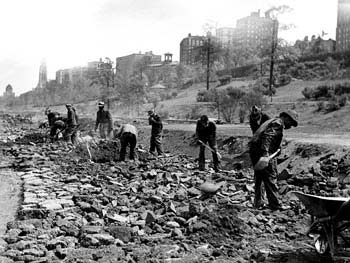
Construction Laborers, Riverside Park, May 16, 1934
New York City Parks Photo Archive, Neg. 0594Described in the Parks Department's photographer's journal as a “colored gang,” this group of Black laborers is shown laying foundation stones in the shallow river bed that was to become part of the Riverside Park expansion.
One of the largest public improvements to ever take place in New York City, this massive project decked over the New York Central Railroad, doubled the park's acreage, and added the scenic Henry Hudson Parkway along its perimeter.
Financed by the Federal Works Progress Administration (WPA), the workforce numbered in the many thousands. Notice the harmonica player at center who tries to maintain the work crew's spirits in the face of their daunting task.
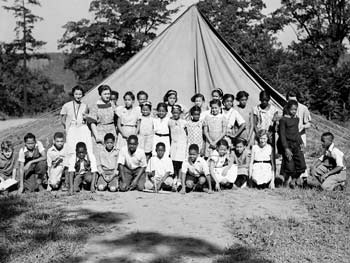
Day Camp, Inwood Hill Park, August 20, 1934
New York City Parks Photo Archive, Neg. 1072Following the consolidation of the City's parks system under Commissioner Robert Moses in January 1934, the Parks Department announced plans to establish day camps for 2,500 children with both an educational and recreational mission.
The activities were jointly managed by Parks Department play leaders, as well as staff from the Board of Education. The day camp depicted here was at the northern tip of Manhattan near the “old House of Mercy,” and afforded views from the bluffs overlooking the Hudson.
The programs consisted of games, nature and geology studies, arts and crafts, story telling, drama, and community singing among various activities, and children were provided free transportation and lunch.
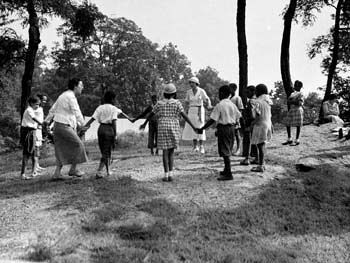
Day Camp, Inwood Hill Park, August 20, 1934
New York City Parks Photo Archive, Neg. 1069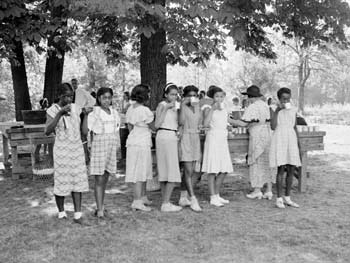
Day Camp, Inwood Hill Park, August 20, 1934
New York City Parks Photo Archive, Neg. 1071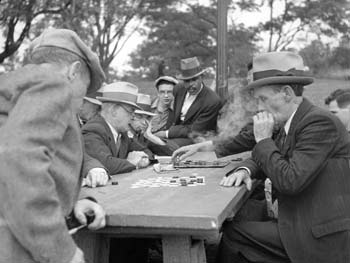
Checkers Players, Fort Greene Park,
Brooklyn, September 24, 1934
Alajos Schuszler/New York City Parks Photo Archive, Neg. 4028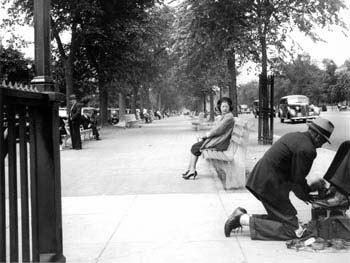
Shoe Shine, Eastern Parkway, Brooklyn, June 10, 1938
Alajos Schuszler/New York City Parks Photo Archive, Neg. 13656Though most shoe shine operations are located in dense, business districts, here the bootblack plies his trade at the workingman's place of origin–a subway entrance–along Eastern Parkway.
The grand landscaped boulevard, the creation of Frederick Law Olmsted and Calvert Vaux, co–designers of Central and Prospect Parks, dates to 1868.
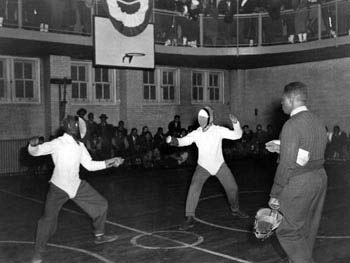
Fencing Contest, Hansborough Recreation Center, Manhattan, January 6, 1940
New York City Parks Photo Archive, Neg. 18193This fencing competition was part of a full day of athletic competition at the recreation center that also included gymnastics, boxing, basketball, and swimming races. The festivities were launched by a marching band. The recreation center, originally known as the 134th Street Natatorium, opened in 1925, and is notable for its decorative architecture. The facility was named in honor of John Rozier Hansborough Jr. (1907-1981), a former Parks recreational employee from 1929 to 1975, and Harlem community leader. Hansborough also broke the color barrier as one of the first two African Americans in the International Association of Approved Basketball Officials.
In 1988, his widow Audrey S. Hansborough founded a conservancy in his memory that helps support the maintenance and management of Harlem's parks, playgrounds, and recreation centers. In recent years fencing has surged among African-American urban youth programs sponsored by such organizations as the Peter Westbrook Academy.
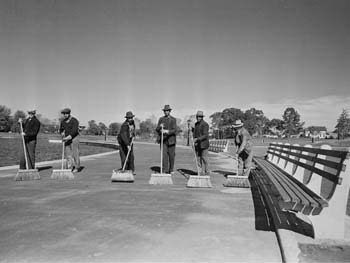
Park Maintenance Crew Cleans Walkway, Baisley Pond Park, Queens, October 16, 1940
Rodney McCay Morgan/New York City Parks Photo Archive, Neg. 19369Workers give a clean sweep to the finishing touches of a large–scale renovation of Baisley Pond Park north end, reopened without ceremony on October 30, 1940.
The renovation included two new playgrounds and one remodeled playground, handball courts, tennis courts, three baseball diamonds, and a football field.
The 30–acre pond was drained and reconfigured at that time with a semi–circular concrete basin, new boat landings, and a wide bench–lined perimeter path.
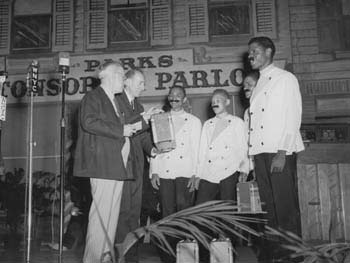
Grand Central Red Caps, Winners, 7th Annual, Barbershop Quarter Contest, Central Park, June 26, 1941
New York City Parks Photo Archive, Neg. 20426The International Brotherhood of Red Caps, a largely Black union of railway service workers was founded in 1937, following the unionization of Pullman Porters, the first predominantly African American union led by A. Phillip Randolph’s efforts beginning in 1925.
At the contest whose winners are shown here, eighteen teams of balladeers competed in the traditional a cappella musical form of barbershop quartet singing–a favorite of Commissioner Robert Moses--and this contingent of Grand Central Red Caps, with a repertoire of spirituals, won before a jubilant crowd of 15,000 people, upsetting several favored perennial teams.
The competitors in this event were said to be “drawn from every walk of life embracing commercial, industrial, social and civic organizations.” Among the jurors were Mayor Fiorello La Guardia, former governor Alfred E. Smith, and orchestra leader Fred Waring.
The win qualified the Black quartet of railway workers (Robert, Owen and Jack Ward, William Bostic) as the representative of New York City at the national competition held the following week in St. Louis, but they were denied their rightful place by organizers who in justifying their actions commented “that to keep down any embarrassment we ought not to permit colored people to participate.”
In protest, Moses and Smith resigned their membership as vice presidents of the Society for the Preservation and Encouragement of Barber Shop Quartet Singing in America.
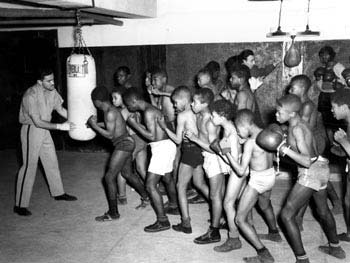
Boxing Instruction, Colonial Park Recreation Center, Manhattan, February 17, 1942
New York City Parks Photo Archive, Neg. 21268In December 1941, the Parks Department announced the inauguration of a boxing instruction program at nine park recreation buildings, including the Colonial Park Play Center in West Harlem.
Parks recreation personnel were trained to teach “the fundamentals of the art of self–defense.” Former World Heavy–weight champ Gene Tunney was a special advisor to the program which was sponsored by Bernard Gimbel, president of the Gimbel's department store.
The program was aimed at young men and boys over 14 years old, and was intended “to enhance physical well being?in wholesome surroundings.”
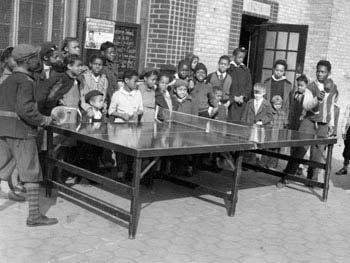
Ping–Pong, Mount Morris Park, Manhattan, April 26, 1943
New York City Parks Photo Archive, Neg. 22284Children play ping pong at the then recently built athletic facility in Mount Morris Park (now known as Marcus Garvey Park).
This appears to be an elimination round in the New York Community Trust's Spring Sports Tournament (note the tourney poster on the wall), in which the ping pong finals took place a few days later on May 1.
Over twenty thousand boys and girls, between the ages of 12 and 18, took part in the tournament, which was held in thirteen sports at numerous parks and recreation facilities citywide.
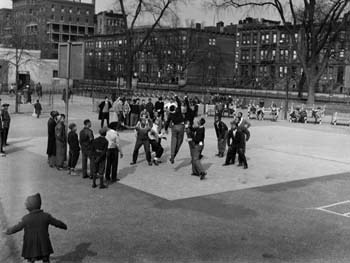
Boys Basketball, Mount Morris Square, Manhattan, April 26, 1943
Alajos Schuszler/New York City Parks Photo Archive, Neg. 22285A row of staid 19th–century row houses defining the square's perimeter contrasts with the more active pursuits of boys on the newly built basketball courts within the park's borders.
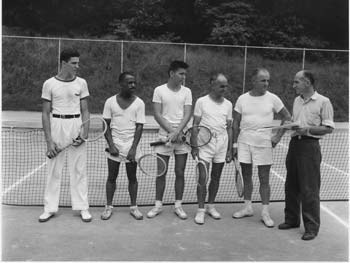
Men’s Tennis Class, Forest Park,
Queens, July 11, 1943
Neg. 22490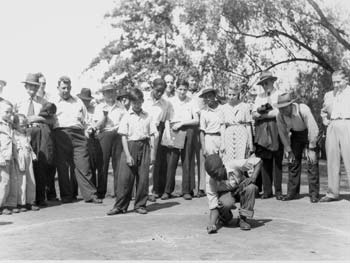
Marbles Tournament Winner and Runner-Up, Central Park,
Manhattan, June 30, 1945
Thompson/New York City Parks Photo Archive, Neg. 24248The game of marbles may be traced back to ancient Egypt and Rome. In old New York it was a popular children’s pastime in the streets before they were even paved. In this photograph Thomas Roberts, the Highbridge Park champ from Washington Heights, is poised to play as Anthony Dellatacoma, the Columbus Park victor from the Lower East Side, and others await the outcome of the inter-park marbles finals on a patch of ground in Central Park. Roberts was the eventual winner of this contest, sponsored by the Daily Mirror newspaper.
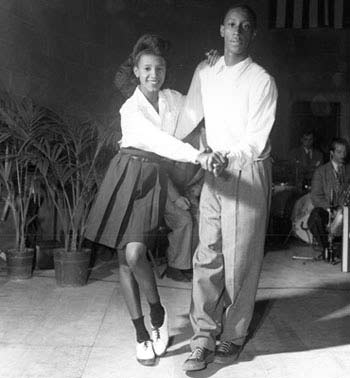
Jitterbug Winners, Moon Dance, Central Park Bandshell, September 5, 1946
New York City Parks Photo Archive, Neg. 24797This debonair couple was the first place winner in the ?jitterbug? category of the dance contest held in Central Park. Also known as the “Lindy Hop,” the dance combined set steps with improvisation.
It originated in Harlem in the 1920s and evolved from the Charleston, the Collegiate, the Breakaway, and the Texas Tommy. Certain aspects of the jitterbug can be traced to African and early African–American dance forms.
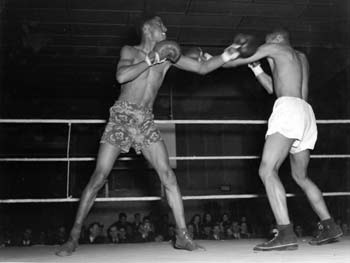
Cromwell Recreation Center Boxing Match, Cromwell Recreation Center,
Staten Island, March 27, 1952
Neg. 21375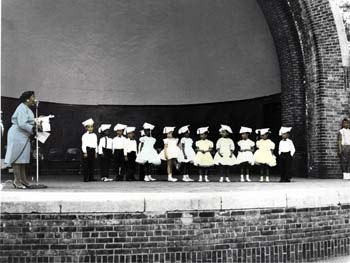
Sixth Annual May Festival, Colonial Park (now Jackie Robinson), May 19, 1962
New York City Parks Photo Archive (hand–colored by Ellen Wallenstein)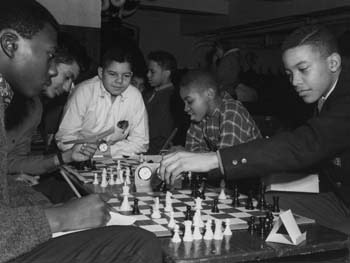
Chess Tournament, J. Hood Wright Park, Manhattan, February 29, 1964
New York City Parks Photo Archive, Neg. 35587-6Developing mind rather than muscle, chess players have had a long association with the parks of New York.
For more than sixty years, many of the standard park and playground designs have included outdoor chess and checkers gaming tables. In 1952, Parks built the Chess and Checkers House in Central Park--the first municipally–funded permanent structure for this activity.
In Washington Square Park, the southwest corner of the park is especially renowned for lively outdoor chess matches. Here, as part of a borough–wide chess tourney for boys and girls 16 and under in age, city youth concentrate on their next move, displaying an intense competitive spirit despite the provisional quarters at this Washington Heights recreation facility.
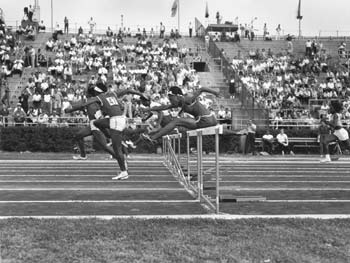
Hurdlers in Randall’s Island Olympics, Randall’s Island,
September 8, 1964
Neg. 32058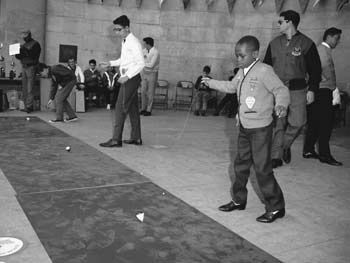
Top Spinning Contest, Central Park Bandshell,
Manhattan, November 7, 1964
New York City Parks Photo Archive, Neg. 35719–10The Parks Department in conjunction with the Duncan Toys Company sponsored annual spin top and yo–yo contests at the bandshell and other park locations. Top spinning was a popular street game transformed here into a competitive sport. The Duncan company sold 56 million yo–yos in 1963, but as the interest waned the firm filed for bankruptcy in 1965. In recent years the company and its products have revived.
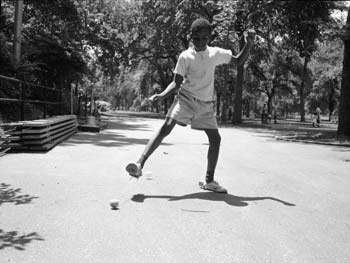
Child Playing Jingle Jump, Central Park Mall,
Manhattan, 1965
New York City Parks Photo Archive, Neg. 35755–15This toy was popular at the time of the hula hoop craze during the late 1950s and early 1960s. Much like hula hoop play, groups of kids often gathered to jingle jump together in playgrounds and parks in New York. The goal is to clear the rotating weighted rope, and the skill bears resemblance to Double Dutch jump rope–a popular sport among urban African-American girls.
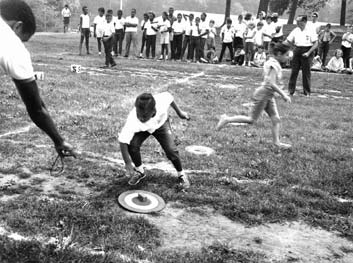
Playcamp Jamboree, Prospect Park,
Brooklyn, August 17, 1965
Ben Cohen/New York City Parks Photo Archive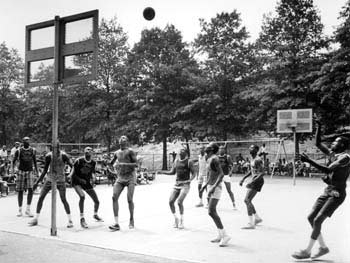
Basketball, Rucker League, Mount Morris (now Marcus Garvey) Park, July 23, 1966
New York City Parks Photo Archive, Neg. 40224Holcombe Rucker (1926–1965) worked as a playground director at numerous Harlem parks from 1948 to 1964. In 1947, he started a basketball league and tournament in Harlem, founded on the motto, “each one, teach one”, that sought to combine education and recreation.
By the 1960s Rucker had transformed his local league into a legendary basketball venue in which top notch professionals such as Wilt Chamberlain, Connie Hawkins and Kareem Abdul Jabar (then Lew Alcindor) shared the court with amateur players and legendary “street” athletes.
Rucker's original tournament continues at Colonel Charles Young Playground, and in 1974 PS 156 Playground was renamed in Rucker's memory.
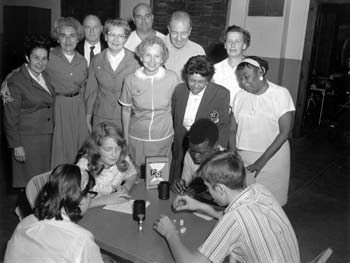
Perquackey contest, Lost Batallion Hall,
Queens, September 10, 1966
New York City Parks Photo Archive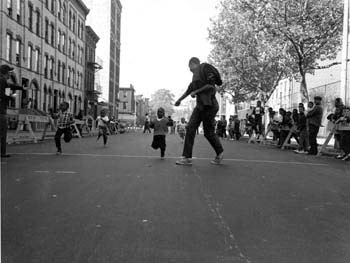
Sports Festival, Ralph Avenue and Madison Street, Brooklyn, October 8, 1966
Ben Cohen/New York City Parks Photo ArchiveThis sports festival was held by the Parks Department on Madison Street, an extra–long “super block” in Bedford–Stuyvesant, Brooklyn that was able to accommodate events such as an 888–yard relay race.
There were also potato sack races, a standing broad jump competition, and races for small children. The event was sponsored by Buy–Rite discount stores.
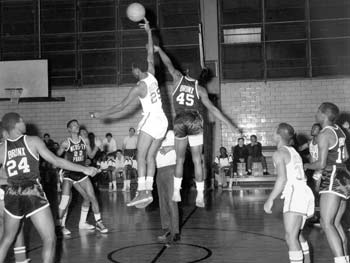
Opening Tip-off of Basketball Game, St. Mary’s Park,
Bronx, March 3, 1967
New York City Parks Photo Archive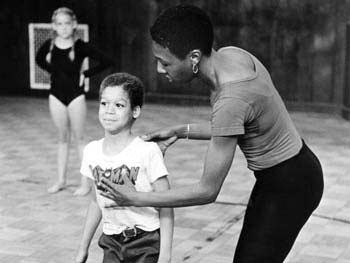
Dance Theater Workshop, Public School Gymnasium at W. 65th Street, Manhattan, July 9, 1968
Katrina Thomas/New York City Parks Photo Archive, Neg. 50040–31Gordon Duffey, a member of Parks' recreation staff, directed the Theater Workshop, which employed improvisational techniques and conducted repertory–style productions. It included dance programs for inner–city youth.
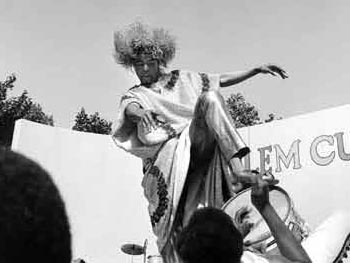
Harlem Cultural Festival, Mount Morris (now Marcus Garvey) Park, July 21, 1968
Daniel McPartlin/New York City Parks Photo Archive, Neg. 53197–7A La Rocque Bey dancer performs while a drummer beneath him provides a percussive beat.
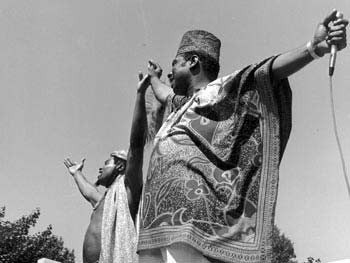
Harlem Cultural Festival, Morris (now Marcus Garvey) Park, July 21, 1968
Daniel McPartlin/New York City Parks Photo Archive, Neg. 53197–7Two male performers with arms outstretched acknowledge audience applause.
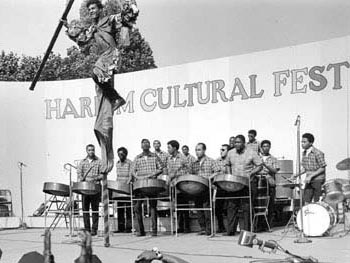
Harlem Cultural Festival, Mount Morris (now Marcus Garvey) Park, July 28, 1968
Daniel McPartlin/New York City Parks Photo Archive, Neg. 53198.16A stilt dancer performs to music provided by a steel drum band. On this day, the Harlem Cultural Festival was dedicated to Latin and Calypso music.
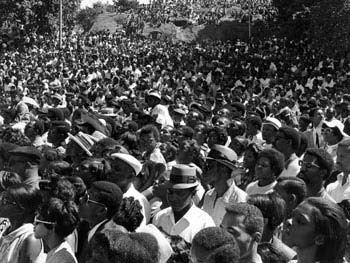
Harlem Cultural Festival, Mount Morris (now Marcus Garvey) Park, August 11, 1968
Daniel McPartlin/New York City Parks Photo Archive, Neg. 40154Staged in what was then known as Mount Morris Park, the Harlem Cultural Festival was a new series of summer concerts featuring headliner acts, and produced by Tony Lawrence.
On this day, featured performers were Joe Tex, King Curtis and his Kingpins, Bobby “Blue” Bland, Charlie and Inez Fox, and the Lou Parks Soul Dancers.
An irrepressible Lawrence characterized the festival as the “best entertainment in New York this summer,” and credited Mayor John V. Lindsay as “a soul brother downtown who is working hard for us.”
For those not among the audiences of up to 25,000 people crowding the square and its rocky outcroppings, the open–air concerts were taped and broadcast in September on WNEW–TV, Channel 5.
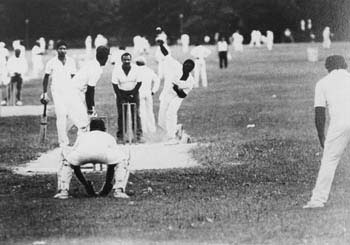
Cricket, Van Cortlandt Park, The Bronx, August 23, 1987
Calvin Wilson/New York City Parks Photo Archive, Neg. 60185.34There is a long tradition of cricket in the parks of New York City. As early as 1857, the Board of Commissioners of Central Park planned a cricket ground, for the “encouragement of, and indulgence in, athletic and manly sports.”
At the Parade Ground opposite Prospect Park, the broad lawns helped accommodate the growing interest in the sport in the late 1870s.
In recent years, a growing West Indian population plays cricket on the Parade Ground in Van Cortlandt Park, the largest such open space in the city.
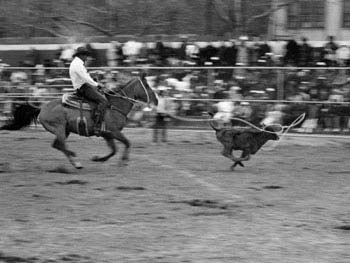
Fifth Annual Black World Championship Rodeo, Cowboy Lassoes Calf, Colonel Charles Young Playground, Manhattan, April 16, 1988
Malcolm Pinckney/New York City Parks Photo Archive, Neg. 60277–94Although the first Black Rodeo in the United States is said to have been held in the 1920s, the first such event in New York City Parks did not take place until 1984.
The local rodeo has been sponsored by the Federation of Black Cowboys, an organization that formalized in 1994, and is dedicated to perpetuating a culture of western horsemanship born in the frontier days of America.
The Federation has a mission to educate the public, and in particular children, in a little known history, as well as to transmit a message of proper care and handling of horses. The Federation maintains its headquarters at the Cedar Lane Stables in Howard Beach, Queens.
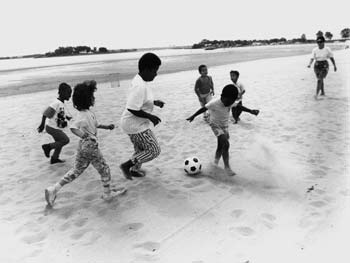
Children Playing Soccer, Orchard Beach,
Bronx, May 23, 1989
New York City Parks Photo Archive, Neg. 60558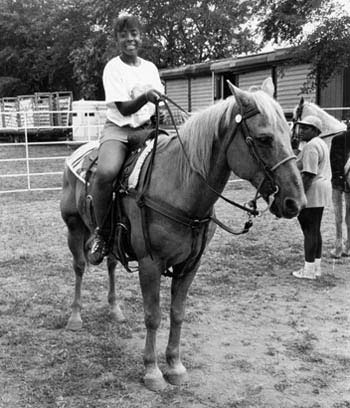
Girl on Horse, 10th Black Rodeo, Downing Stadium, Randall's Island, July 8, 1993
Simon Benepe/New York City Parks Photo Archive, Neg. 61011.50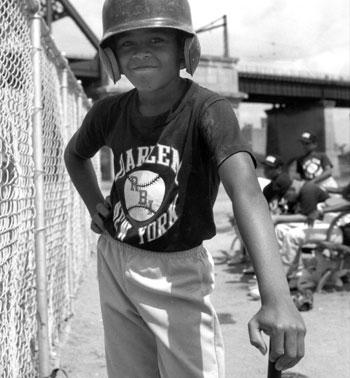
Boy with Helmet, Harlem RBIS, Randall’s Island,
August 5, 1993
Simon Benepe/New York City Parks Photo Archive, Neg. 61025
image has been croppedThe Harlem RBIs is a youth athletic and social service organization founded in 1991. One of its early actions was to convert two abandoned vacant lots in East Harlem into viable baseball diamonds. In 2002 the City of New York licensed the group to rebuild and manage this “Field of Dreams.” The non–profit also operates the Dream Charter School, and runs summer programs that include academic instruction and baseball. The organization relies on 90% private funding, and its active engagement with at–risk youth has shown remarkable results. Since 2004, 93% of those enrolled long–term in the Harlem RBI program have graduated from high school and 92% have been accepted in college. The Harlem RBIs are one of the perennial users of Randall’s Island’s baseball fields, which host numerous public school events as well as the state championships.
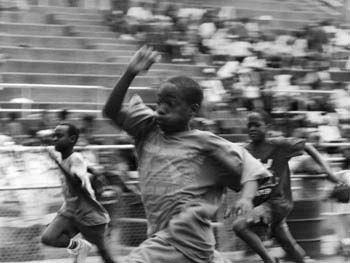
Children's Track Competition, Downing Stadium, Randall's Island, August 10, 1993
Simon Benepe/New York City Parks Photo Archive, Neg. 61027Triborough Stadium (later renamed Downing) opened in July 1936, hosting the American Olympic Track and Field Trials, at which Jesse Owens distinguished himself. This launched a long tradition of track and field events at Randall?s Island, from children?s sporting competitions to college and professional athletics. On April 23, 2005, a new state?of?the?art stadium opened on Randall's Island, named for financier and lead sponsor Carl Icahn. Since 2005 the Randall?s Island Sports Foundation (RISF) has run the Jesse Owens Track and Field Club, providing two eight week seasons in spring and fall. RSFI provides bussing for schools from East Harlem and the South Bronx, and each year serves 500 students, from elementary through middle school.
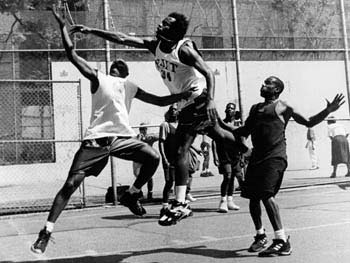
Basketball, West 4th Street Playground, Manhattan, May 20, 1996
Doug Lynn/New York City Parks Photo Archive, Neg. 61771–33Many aficionados believe that the best basketball in New York City is not played at Madison Square Garden, but at West 4th Street. Little more than two hoops, a patch of asphalt, and some chain link fence, this public space is animated by the remarkable athletes who grace the courts. Some professionals, notably Anthony Mason formerly of the New York Knicks, have honed their skills here; others who play here, although not members of the NBA, are of professional caliber.